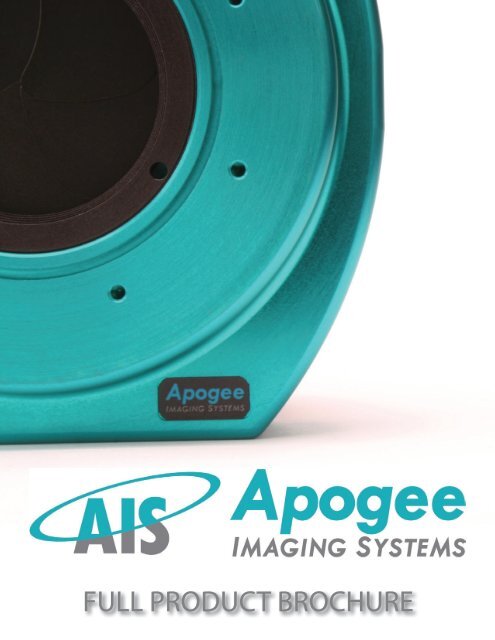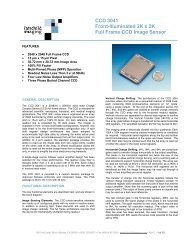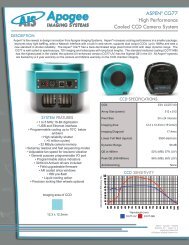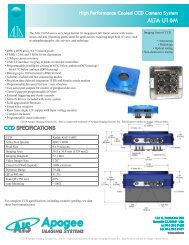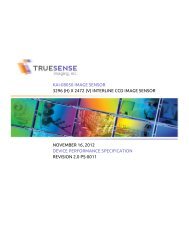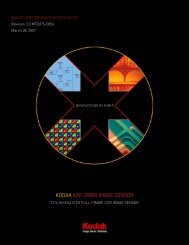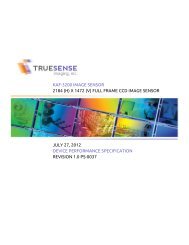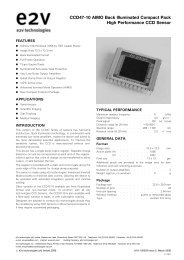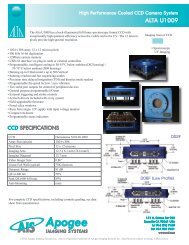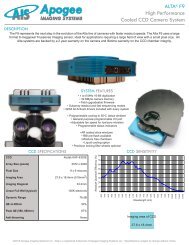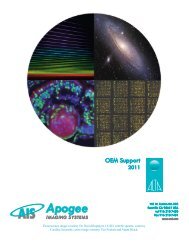Product Overview Brochure - Apogee Instruments, Inc.
Product Overview Brochure - Apogee Instruments, Inc.
Product Overview Brochure - Apogee Instruments, Inc.
You also want an ePaper? Increase the reach of your titles
YUMPU automatically turns print PDFs into web optimized ePapers that Google loves.
FULL PRODUCT BROCHURE
ABOUT APOGEE<br />
APOGEE IMAGING SYSTEMS<br />
High Performance<br />
Cooled CCD Camera System<br />
Our Start<br />
In 1993, <strong>Apogee</strong> <strong>Instruments</strong>, <strong>Inc</strong>. was founded by Wayne Brown, in San Jose, California. Over the course of the next<br />
year <strong>Apogee</strong> developed, tested, and began selling its first line of CCD cameras, the AP ® series. In 1995, <strong>Apogee</strong>’s<br />
strength and determination was proved, as the company relocated to Arizona, in an effort to branch out into the scientific<br />
community. Partnering with the Naval Research Laboratory (NRL), in 1999, <strong>Apogee</strong>’s camera was launched on a<br />
sounding rocket as part of NRL’s VAULT (Very high Angular resolution Ultraviolet Telescope) project.<br />
Equipped with two new camera lines; KX ® and AM ® series, and camera accessories <strong>Apogee</strong> returned to Northern<br />
California in 2001.<br />
A Growing Reputation<br />
Already proven in the astronomy community, <strong>Apogee</strong> worked to expand its customer focus. <strong>Apogee</strong> cameras have<br />
become an integral part in many customers’ applications ranging from volcanology and spectroscopy to areas of medical<br />
research in various facilities spanning the globe. In 2010, <strong>Apogee</strong> <strong>Instruments</strong> announced a name change to <strong>Apogee</strong><br />
Imaging Systems. Although a small change to the name, it represented a significant step in the company’s growth in<br />
both products and customer breadth.<br />
COMMITMENT TO QUALITY<br />
Because you need reliable imaging systems to make your science happen, we strive to develop the best possible quality<br />
assurance system for all of our products, both incoming and outgoing. Through product consistency on incoming inventory<br />
and constant and consistent cross-checking during the build process, we are able to provide our customers with some<br />
of the best quality cameras currently on the market. At <strong>Apogee</strong> we are continually seeking to find ways to make our<br />
manufacturing processes faster and more efficient, while still maintaining the high level of quality our customers expect from<br />
us. Our knowledgeable engineering staff works side-by-side with the members of our production team to ensure that new<br />
products not only meet our customers needs, but are also faster and easier to assemble, so you get your camera on time.<br />
CORE VALUES<br />
Here at <strong>Apogee</strong> Imaging Systems, there are four keys values<br />
we focus on as a company:<br />
Strive for excellence.<br />
In our jobs and in our products, we want to produce our very<br />
best...every time.<br />
Practice honesty and integrity.<br />
These values are the core of our relationships both in house,<br />
with one another, and with our customers.<br />
Extraordinary Partnerships<br />
For two years <strong>Apogee</strong>’s engineering team worked intently with NASA’s Marshall Space Flight Center, to design a<br />
custom camera to fly aboard a Black Brant sounding rocket, as part of NASA’s High Resolution Coronal Imager, or Hi-C<br />
project. In 2012, NASA successfully launched the rocket carrying the <strong>Apogee</strong> camera to observe the solar corona and<br />
fundamental structures of the sun providing images with six times better resolution than ever before.<br />
<strong>Apogee</strong> Today<br />
With more than 20 years of experience, <strong>Apogee</strong> Imaging Systems continues to supply reliable, high performance cooled<br />
CCD cameras to many disciplines within the scientific community.<br />
Focus on the customer.<br />
We provide great customer service, both before and after<br />
the sale. We try our hardest to go the extra mile for every<br />
customer.<br />
Have fun at work.<br />
We are a growing yet small company...some call it an extended<br />
family. But first and foremost, we have all found a home at<br />
<strong>Apogee</strong> because we enjoy what we do!<br />
DIVERSITY<br />
From government and private research laboratories to worldclass<br />
professional observatories, our cameras are now used in<br />
more than 50 different countries. <strong>Apogee</strong> cameras have been<br />
used for a wide variety of applications, such as: spectroscopic<br />
analysis of water, soil and gems; detection of anthrax; analysis<br />
and detection of contaminants at nuclear reactors; imaging<br />
of fingerprints without chemicals; fluorescent imaging of cell<br />
tissues and microtitre plates; munitions testing; laser beam<br />
profiling; optics testing; and the discovery of astronomical<br />
objects.<br />
NGC 6853, The Dumbbell Nebula taken by R Jay GaBany with an<br />
<strong>Apogee</strong> Ascent ® A8050 using a Half-meter RCOS f/8<br />
CUSTOMER SUPPORT<br />
One of <strong>Apogee</strong>’s top priorities is our dedication to our<br />
customers. Whether it is assisting with CCD selection,<br />
helping you build your order , talking through customization<br />
options, helping you troubleshoot remotely or answering<br />
any questions you may have about your new camera,<br />
our customer and sales support staff is always on hand,<br />
eager to help with any of your needs or questions.<br />
Sales Support:<br />
sales@ccd.com<br />
Technical Support:<br />
support@ccd.com<br />
tel: (916) 218-7450 x 219<br />
hours: 9am to 5pm PST<br />
MADE IN THE USA<br />
<strong>Apogee</strong> is proud to boast that all it’s cameras are<br />
assembled and tested in our Northern California facility.<br />
Almost all of the mechanical parts involved in the<br />
manufacturing of <strong>Apogee</strong> cameras are produced in our<br />
own separate machining facility with three 3-axis CNC<br />
machines.<br />
©2013 <strong>Apogee</strong> Imaging<br />
Systems <strong>Inc</strong>. Aspen, Alta and<br />
Ascent are registered trademarks of<br />
<strong>Apogee</strong> Imaging Systems <strong>Inc</strong>.<br />
By expanding into broad markets with diverse demands,<br />
<strong>Apogee</strong> has had to develop a wide variety of technologies<br />
to fit our customers’ wide array of needs. Be it low noise<br />
and high sensitivity coupled with high quantitative accuracy<br />
or speed and ease of use, there is one thing all our customers<br />
need: high performance at lower prices. At <strong>Apogee</strong>, we work<br />
our hardest to meet all your demands.<br />
Image by <strong>Apogee</strong> personnel<br />
COMPANY INFORMATION
OUR CAMERAS<br />
PRODUCT INFORMATION<br />
High Performance<br />
Cooled CCD Camera System<br />
<strong>Apogee</strong> currently manufactures three camera lines: Alta ® F Series, Ascent ® and now introducing Aspen ® . Each product<br />
line supports a wide variety of CCD sensors. Below is a chart comparing the vital system features of each camera type<br />
to better help you determine which product will best suit your needs. Our sales staff is always on hand to assist with<br />
any questions you may have or to help you select which camera would best suit your individual needs or the needs of<br />
your company.<br />
Ascent ® Alta ® Aspen ®<br />
Digitization 16 bit, programmable speed Fast 12 bit and slower 16 bit 16 bit, programmable speed<br />
Maximum throughput Up to 16 Mpixels/sec Up to 7 Mpixels/sec Up to 16 Mpixels/sec<br />
Dual channel readout Standard on most Interline CCDs N/A Standard on most Interline CCDs<br />
Progressive scan for<br />
interlines<br />
Standard Standard Standard<br />
Video focus mode Standard N/A N/A<br />
Maximum cooling up to 40ºC below ambient up to 55ºC below ambient up to 70ºC below ambient<br />
Temperature regulation ± 0.1 ºC ± 0.1 ºC ± 0.1 ºC<br />
Programmable gain and<br />
offset<br />
Standard N/A High speed mode only<br />
USB2 interface Standard Standard Standard<br />
Ethernet N/A N/A 2 Mpixels/sec<br />
Electromechanical<br />
shutter<br />
Programmable fan<br />
speed<br />
Field upgradeable<br />
firmware<br />
N/A Standard on FF, opt on Interline Standard on FF, opt on Interline<br />
N/A Standard Standard<br />
Standard Standard Standard<br />
Chamber window Fused silica Fused silica Fused silica<br />
Peripheral<br />
communications<br />
General purpose I/O<br />
port<br />
8 pin mini-DIN connector 8 pin mini-DIN connector 8 pin mini-DIN connector<br />
Standard Standard Standard<br />
Programmable LEDs Standard Standard Standard<br />
Power input 6V 12V 12V<br />
Internal memory 32 Mbytes 32 Mbytes 32 Mbytes<br />
CCDs supported Interline only Full frame, Interline, Spectroscopy Full frame, Interline, Spectroscopy<br />
External triggering Standard Standard Standard<br />
Image sequences up to 65535 images up to 65535 images up to 65535 images<br />
Hardware binning up to 8 x height of CCD up to 8 x height of CCD up to 8 x height of CCD<br />
Subarray readout Standard Standard Standard<br />
TDI readout & Kinetics<br />
mode<br />
N/A Standard on Full Frame TDI only<br />
Back focal distance 0.32” (8.1 mm) 0.69” (17.5 mm) and up 0.69” (17.5 mm) and up<br />
C-mount interface Optional, external Standard for D01 & D03 housings Standard for G01<br />
Housing size (small) 4.8” x 3.25” x 3.25” 6” x 6” x 2.1” to 2.7” 6.5” x 6.4” x 3.8” to 4.3”<br />
Housing size (large) N/A 7” x 7” x 2.7” to 4.1” 6.5” x 6.4” x 4.7”<br />
Warranty (parts & labor) 2 years 2 years 2 years<br />
Warranty against<br />
condensation<br />
Lifetime Lifetime Lifetime<br />
©2013 <strong>Apogee</strong> Imaging<br />
Systems <strong>Inc</strong>. Aspen, Alta and<br />
Ascent are registered trademarks of<br />
<strong>Apogee</strong> Imaging Systems <strong>Inc</strong>.<br />
TWO-YEAR WARRANTY<br />
All <strong>Apogee</strong> cameras are backed with a twoyear<br />
warranty on the camera and a lifetime<br />
warranty on the CCD chamber integrity.<br />
Warranty extensions are available for an<br />
additional fee.<br />
INTERNAL MEMORY<br />
Each <strong>Apogee</strong> system is equipped with<br />
32Mbytes of SDRAM image memory. This<br />
localized memory is important for two<br />
reasons: firstly, to buffer the image transfer,<br />
protecting it from any noise-producing<br />
interruptions that may incur during the<br />
process. Secondly, it allows for faster<br />
digitization of image sequences, up to the<br />
limit of the internal memory of the camera.<br />
FIELD UPGRADEABLE FIRMWARE<br />
Every camera arrives coded with<br />
information that identifies the type of system<br />
you have received, it’s configuration, the<br />
CCD used in it and the revision number of<br />
the active firmware. For an added level of<br />
convenience, the most current drivers and<br />
firmware updates are always available<br />
for download on our website (Support ><br />
Drivers & Downloads), allowing cameras<br />
to be updated at any time, from anywhere<br />
and making it easier for <strong>Apogee</strong> Customer<br />
Support staff to troubleshoot remotely when<br />
necessary.<br />
LIQUID COOLING<br />
<strong>Apogee</strong> offers a liquid cooling option on both<br />
the Alta ® and Aspen ® systems. By putting<br />
a liquid recirculation plate in place of the<br />
fans, the chiller unit is about to remove heat<br />
from the camera body to reduce warm air<br />
disturbance around the camera. In some<br />
cases additional cooling may be gained,<br />
but the camera housing must not be cooled<br />
below the dew point.<br />
Aspen G01 Liquid Recirculation camera<br />
Our general purpose I/O<br />
port can be used for a wide<br />
variety of external trigger<br />
inputs, including line-by-line<br />
control of TDI shifts.<br />
EXTERNAL TRIGGERING<br />
External hardware triggers can<br />
be utilized through a general I/O<br />
port available on every <strong>Apogee</strong><br />
system. External triggers can be<br />
coupled with software triggers and<br />
used in a variety of ways to trigger<br />
image sequences. A software<br />
or hardware trigger can be used<br />
to initiate a single exposure or a<br />
sequence of exposures for a set<br />
duration and delay between each<br />
exposure. A software trigger may<br />
also be used to start a sequence<br />
with the external trigger used to<br />
trigger each subsequent image.<br />
The external trigger can also be<br />
used to trigger row shifts for timedelayed<br />
integration or it can be<br />
used to trigger block shifts for<br />
kinetic imaging.<br />
PROGRESSIVE SCAN<br />
Interline transfer CCDs go through<br />
a process in which they first shift<br />
charge from the photodiode in<br />
each pixel to the masked storage<br />
diode, then march the charge<br />
through the storage diodes to the<br />
serial register. Acquisition of a new<br />
image in the photodiodes during<br />
readout of the previous image<br />
is called “progressive scan” or<br />
continuous imaging. This feature is<br />
available on every interline transfer<br />
supported camera.<br />
PROGRAMMABLE FANS<br />
Due to customer demand, in both<br />
the Alta ® and Aspen ® camera series<br />
the fans may be turned completely<br />
off or run at a much slower speed to<br />
maintain adequate cooling with no<br />
vibration. For applications where<br />
vibration is not as big of a concern,<br />
the fan speed may be maximized<br />
for greatest cooling.<br />
PROGRAMMABLE LEDS<br />
There are two LEDs visible through<br />
each camera faceplate to show status<br />
of a variety of the camera’s functions,<br />
such as the camera has reached the<br />
set temperature, the shutter is open or<br />
the camera is waiting for an external<br />
trigger. And if stray light is a concern,<br />
the LEDs can be turned off.<br />
HARDWARE BINNING<br />
All <strong>Apogee</strong> cameras support hardware<br />
binning up to 8 in the horizontal direction<br />
and up to the height of the CCD in the<br />
vertical direction. Binning can be used<br />
to increase frame rate, dynamic range<br />
or apparent sensitivity by collecting<br />
more light into a superpixel. For more<br />
information about the benefits of pixel<br />
binning, visit the CCD University on our<br />
website.<br />
PRODUCT INFORMATION
DESCRIPTION<br />
ASPEN ®<br />
High Performance<br />
Cooled CCD Camera System<br />
Aspen ® is the newest in design innovation from <strong>Apogee</strong> Imaging Systems. Aspen ® increases cooling performance in a<br />
smaller package, improves stray light baffling, adds a Network interface with a built-in web server, supports dual output<br />
CCDs up to 16Mhz and sets a new standard in shutter reliability. All Aspen ® systems are backed by a 2 year warranty<br />
on the camera and lifetime warranty on the CCD chamber integrity.<br />
PC Interface<br />
SYSTEM SPECIFICATIONS<br />
USB 2.0 to 16MHz; Network interface<br />
with built-in web server, up to 2MHz<br />
throughput<br />
G01 - STANDARD FOR SMALL CCDS<br />
G07 - STANDARD FOR LARGE CCDS<br />
1” Aperture<br />
C-Mount<br />
1-32 UN-2B<br />
.68” Flange Focal Distance<br />
(optical)<br />
35mm shutter on Full Frame<br />
CCDs<br />
No shutter on Interline CCDs<br />
Liquid Recirculation Available<br />
Max. Cable Length<br />
USB: 5 meters between hubs; 5 hubs<br />
maximum (max. total of 30m)<br />
Ethernet: 100 meters maximum<br />
2.25” Aperture<br />
3” Thread Option<br />
Optional Thread-in Fieldstop<br />
Digital Resolution<br />
System Noise (typical)<br />
16 bits, single or dual channel<br />
7 e - RMS at 1 MHz<br />
1.01” Flange Focal Distance<br />
(optical)<br />
SYSTEM FEATURES<br />
• 1 to 16 MHz 16-Bit digitization<br />
• USB and Ethernet interface<br />
• Programmable cooling up to 70°C below ambient<br />
• High reliability shutter (>5 million cycles)<br />
Pixel Binning<br />
Exposure Time<br />
Image Sequencing<br />
Frame Sizes<br />
1 x 1 to 8 x height of CCD<br />
Interline CCDs:<br />
100 microseconds to 183 minutes<br />
Full Frame & Spectroscopy CCDs:<br />
100 milliseconds to 183 minutes<br />
(2.56 microsecond increments)<br />
1 to 65535 image sequences under<br />
software control<br />
Full frame, subframe, focus mode<br />
G06 - OPTIONAL LOW PROFILE<br />
58mm shutter on Full Frame and<br />
Spectroscopy CCDs<br />
No shutter on Interline CCDs<br />
Liquid Recirculation Available<br />
2.25” Aperture<br />
• 32 MByte camera memory<br />
• Subarray readout and fast sequencing modes<br />
• Adjustable fan speed for low/zero vibration<br />
• General purpose programmable I/O port<br />
• Programmable status indicators<br />
• Dual channel CCD support<br />
• 32/64 bit ActiveX drivers included with every system<br />
• Field upgradeable firmware<br />
Cooling (typical)<br />
Dark Current (typical<br />
for interline and frontilluminated<br />
CCDs)<br />
Temperature Stability<br />
Thermoelectric cooler with forced air.<br />
Maximum cooling up to 70°C below<br />
ambient temperature.<br />
0.01 e - /pixel/sec (-30°C)<br />
+/- 0.1 o C<br />
.55” Flange Focal Distance<br />
(optical)<br />
No shutter<br />
Liquid Recirculation Available<br />
• AR coated silica windows<br />
• RBI pre-flash on non-Interline CCDs<br />
•Moisture free chambers<br />
• Liquid cooling options<br />
• Precision locking filter wheels optional<br />
Operating Environment<br />
Power<br />
-25º to 40ºC. Relative humidity: 10 to<br />
90% non-condensing.<br />
50W maximum power with cooling<br />
maximum. AC/DC “brick” supply with<br />
int’l AC input plug (100-240V, 50-60Hz).<br />
Alternate 12V input from user’s source.<br />
G09 - HIGHEST COOLING OPTION<br />
2.25” Aperture<br />
3” Thread Option<br />
Optional Thread-in Fieldstop<br />
Remote Triggering<br />
Op. System Support<br />
Featured Accessories<br />
LVTTL input allows exposure to start<br />
within 25 microseconds of rising edge<br />
of trigger.<br />
Windows, Macintosh, Linux<br />
AFW50-7S Filter Wheel, AFW50-9R<br />
Filter Wheel, AFW50-10S Filter Wheel<br />
and AFW31-17R Filter Wheel<br />
1.36” Flange Focal Distance<br />
(optical)<br />
58mm shutter on Full Frame and<br />
Spectroscopy CCDs<br />
No shutter on Interline CCDs<br />
Liquid Recirculation Available<br />
©2013 <strong>Apogee</strong> Imaging<br />
Systems <strong>Inc</strong>. Aspen, Alta and<br />
Ascent are registered trademarks of<br />
<strong>Apogee</strong> Imaging Systems <strong>Inc</strong>.<br />
151 N. Sunrise Ave. Ste 902<br />
Roseville CA 95661 USA<br />
www.ccd.com<br />
tel 916 218 7450<br />
fax 916 218 7451<br />
ASPEN®
ASPEN ® - G07 CONFIGURATION<br />
ASPEN ®<br />
High Performance<br />
Cooled CCD Camera System<br />
FULL FRAME CCDS<br />
Model CCD Array Size<br />
INTERLINE TRANSFER CCDS<br />
Pixel Size<br />
(microns)<br />
Array size (mm)<br />
X<br />
Y<br />
Imaging Area<br />
(mm2)<br />
Diagonal<br />
(mm)<br />
CG1 KAF-0402ME 768 512 9 6.9 4.6 31.9 8.3 M<br />
CG2 KAF-1603ME 1536 1024 9 13.8 9.2 127.4 16.6 M<br />
CG6 KAF-1001E 1024 1024 24 24.6 24.6 604 34.8 M<br />
CG9 KAF-6303E 3072 2048 9 27.6 18.4 509.6 33.2 M<br />
CG32 KAF-3200 2184 1472 6.8 14.9 10 148.7 17.9 M<br />
CG47 E2V CCD47-10** 1024 1024 13 13.3 13.3 177 18.8 M<br />
CG77 E2V CCD77-00** 512 512 24 12.3 12.3 151 17.4 M<br />
CG260 KAF-261E 512 512 20 10.2 10.2 104.9 14.5 M<br />
Mono=M<br />
Color=C<br />
CG8300 KAF-8300CE 3448 2574 5.4 18.6 13.9 259 23.2 M, C<br />
CG3041 Fairchild 3041 2048 2048 15 30.7 30.7 944 43.4 M<br />
CG42 E2V CCD42-40** 2048 2048 13.5 27.6 27.6 764 39.1 M<br />
CG230 E2VCCD230-42** 2048 2048 15 30.7 30.7 944 43.4 M<br />
CG9000 KAF-9000 3058 3058 12 36.7 36.7 1346.6 51.9 M<br />
CG16 KAF-16801E 4096 4096 9 36.9 36.9 1359 52.1 M<br />
CG16M KAF-16803 4096 4096 9 36.9 36.9 1359 52.1 M<br />
Model CCD Array Size<br />
Pixel Size<br />
(microns)<br />
Array size (mm)<br />
X<br />
Y<br />
Imaging Area<br />
(mm2)<br />
Diagonal<br />
(mm)<br />
Mono=M<br />
Color=C<br />
CG285 ICX285AL 1360 1024 6.45 8.8 6.6 57.9 11 M, C<br />
CG1050 KAI-1050 1024 1024 5.5 5.6 5.6 34.8 8.3 M, C<br />
CG2000 KAI-2020 1600 1200 7.4 11.8 8.9 105.1 14.8 M, C<br />
CG2050 KAI-2050 1600 1200 5.5 8.8 6.6 58.1 11 M, C<br />
CG2150 KAI-2150 1920 1080 5.5 10.6 5.9 62.7 12.1 M, C<br />
CG4000 KAI-4022 2048 2048 7.4 15.2 15.2 229.7 21.4 M, C<br />
CG4050 KAI-4050 2336 1752 5.5 12.8 9.6 123.8 16.1 M, C<br />
CG8050 KAI-8050 3298 2472 5.5 18.1 13.6 246.5 22.7 M, C<br />
CG16000 KAI-16000 4872 3248 7.4 36 24 866.5 43.3 M, C<br />
CG16050 KAI-16050 4896 3264 5.5 26.9 17.95 478 32.4 M, C<br />
CG29050 KAI-29050 6576 4384 5.5 36 24 872 43.5 M, C<br />
SPECTROSCOPY CCDS<br />
Model CCD Array Size<br />
Pixel Size<br />
(microns)<br />
Array size (mm)<br />
X<br />
Y<br />
Imaging Area<br />
(mm2)<br />
Diagonal<br />
(mm)<br />
Mono=M<br />
Color=C<br />
CG30 E2V CCD30-11** 1024 256 26 26.6 6.7 177 27.4 M<br />
CG30-OE E2V CCD30-11** 1024 256 26 26.6 6.7 177 27.4 M<br />
CG1007<br />
CG1008<br />
CG1009<br />
CG1107<br />
CG1108<br />
CG1109<br />
Hamamatsu S10140-<br />
1007**<br />
Hamamatsu S10140-<br />
1008**<br />
Hamamatsu S10140-<br />
1009**<br />
Hamamatsu S10140-<br />
1107**<br />
Hamamatsu S10140-<br />
1108**<br />
Hamamatsu S10140-<br />
1109**<br />
1024 122 12 12.3 1.5 18 12.4 M<br />
1024 250 12 12.3 3 36.9 12.6 M<br />
1024 506 12 12.3 6.1 74.6 13.7 M<br />
512 122 12 24.6 1.5 36 24.6 M<br />
1024 250 12 24.6 3 73.7 24.8 M<br />
2048 506 12 24.6 6.1 149.2 25.3 M<br />
©2013 <strong>Apogee</strong> Imaging<br />
Systems <strong>Inc</strong>. Aspen, Alta and<br />
Ascent are registered trademarks of<br />
<strong>Apogee</strong> Imaging Systems <strong>Inc</strong>.<br />
151 N. Sunrise Ave. Ste 902<br />
Roseville CA 95661 USA<br />
www.ccd.com<br />
tel 916 218 7450<br />
fax 916 218 7451<br />
ASPEN®
DESCRIPTION<br />
ALTA ® F SERIES<br />
High Performance<br />
Cooled CCD Camera System<br />
The Alta ® F Series represents the next step in the evolution of the Alta ® line of cameras with faster readout speeds. The<br />
Alta ® line continues to support a wide variety of front-illuminated, back-illuminated and interline transfer CCDs. All Alta ®<br />
systems are backed by a 2 year warranty on the camera and lifetime warranty on the CCD chamber integrity. Current U<br />
Series customers can easily upgrade their systems to F Series, for more information contact <strong>Apogee</strong> Customer Support.<br />
D01/D05 - STANDARD FOR SMALL CCDS<br />
Standard: D01<br />
Low Profile: D05<br />
PC Interface<br />
Max. Cable Length<br />
SYSTEM SPECIFICATIONS<br />
USB 2.0<br />
5 meters between hubs, 5 hubs<br />
max. (max. total of 30m); or up to 50m<br />
with icron 2.0 Ranger extender<br />
D02/D06 - STANDARD FOR MIDSIZE CCDS<br />
Standard: D02<br />
Low Profile: D06<br />
Digital Resolution<br />
16 bits to 8 MHz<br />
SYSTEM FEATURES<br />
• 1 to 8 MHz 16-Bit digitization<br />
• 32 MByte camera memory<br />
• Field upgradeable firmware<br />
• Subarray readout and fast sequencing modes<br />
• 32/64 bit ActiveX drivers included with every system<br />
• Programmable cooling to 55 o C below ambient<br />
• General purpose programmable I/O port<br />
• Adjustable fan speed for low/zero vibration<br />
• Programmable status indicators<br />
System Noise (typical)<br />
Pixel Binning<br />
Exposure Time<br />
Image Sequencing<br />
Frame Sizes<br />
7 to 9 e - RMS at 1 MHz<br />
1 x 1 to 8 x height of CCD<br />
Interline CCDs:<br />
1 millisecond to 183 minutes<br />
Front- and Back-Illuminated CCDs:<br />
20 milliseconds to 183 minutes<br />
(2.56 microsecond increments)<br />
1 to 65535 image sequences under<br />
software control<br />
Full frame, subframe, focus mode<br />
D07/D11 - STANDARD FOR LARGE CCDS<br />
Standard: D07<br />
Low Profile: D11<br />
• AR coated silica windows<br />
• RBI pre-flash available<br />
• Moisture free chambers<br />
• Liquid cooling option<br />
• Precision locking filter wheels optional<br />
Cooling (typical)<br />
Dark Current (typical<br />
for interline and frontilluminated<br />
CCDs)<br />
Thermoelectric cooler with forced air.<br />
Maximum cooling up to 55°C below<br />
ambient temperature.<br />
0.01 e - /pixel/sec (-30°C)<br />
Temperature Stability<br />
+/- 0.1 o C<br />
Operating Environment<br />
Power<br />
-25º to 40ºC. Relative humidity: 10 to<br />
90% non-condensing.<br />
40W maximum power with shutter open<br />
and cooling maximum. AC/DC “brick”<br />
supply with int’l AC input plug (100-<br />
240V, 50-60Hz). Alternate 12V input<br />
from user’s source.<br />
Power<br />
USB<br />
Status<br />
LEDs<br />
I/O Connector<br />
Remote Triggering<br />
LVTTL input allows exposure to start<br />
within 25 microseconds of rising edge<br />
of trigger.<br />
Op. System Support<br />
Windows, Macintosh, Linux<br />
Featured Accessories<br />
AFW50-7S Filter Wheel, AFW50-9R<br />
Filter Wheel, AFW50-10S Filter Wheel<br />
and AFW31-17R Filter Wheel<br />
©2013 <strong>Apogee</strong> Imaging<br />
Systems <strong>Inc</strong>. Aspen, Alta and<br />
Ascent are registered trademarks of<br />
<strong>Apogee</strong> Imaging Systems <strong>Inc</strong>.<br />
151 N. Sunrise Ave. Ste 902<br />
Roseville CA 95661 USA<br />
www.ccd.com<br />
tel 916 218 7450<br />
fax 916 218 7451<br />
ALTA® F SERIES
ALTA ® F SERIES - D07 CONFIGURATION<br />
ALTA ® F SERIES<br />
High Performance<br />
Cooled CCD Camera System<br />
BACK-ILLUMINATED CCDS<br />
Camera<br />
Model<br />
CCD<br />
FRONT-ILLUMINATED CCDS<br />
Array Size<br />
Pixel Size<br />
(microns)<br />
Array size (mm)<br />
Imaging Area<br />
(mm2)<br />
F42 E2V CCD42-40 2048 2048 13.5 27.6 27.6 764 39.1<br />
F230 E2V CCD230-42 2048 2048 15 30.7 30.7 944 43.4<br />
F47 E2V CCD47-10 1024 1024 13 13.3 13.3 177 18.8<br />
F77 E2V CCD77-00 512 512 24 12.3 12.3 151 17.4<br />
F30 E2V CCD30-11 1024 256 26 26.6 6.7 177 27.4<br />
F1109<br />
F1108<br />
F1107<br />
F1009<br />
F1008<br />
F1007<br />
Hamamatsu S10140-<br />
1109<br />
Hamamatsu S10140-<br />
1108<br />
Hamamatsu S10140-<br />
1107<br />
Hamamatsu S10140-<br />
1009<br />
Hamamatsu S10140-<br />
1008<br />
Hamamatsu S10140-<br />
1007<br />
X<br />
Y<br />
Diagonal<br />
(mm)<br />
2048 506 12 24.6 6.1 149.2 25.3<br />
1024 250 12 24.6 3.0 73.7 24.8<br />
512 122 12 24.6 1.5 36.0 24.6<br />
1024 506 12 12.3 6.1 74.6 13.7<br />
1024 250 12 12.3 3.0 36.9 12.6<br />
1024 122 12 12.3 1.5 18.0 12.4<br />
Camera<br />
Model<br />
CCD<br />
Array Size<br />
Pixel Size<br />
(microns)<br />
Array size (mm)<br />
X<br />
Y<br />
Imaging Area<br />
(mm2)<br />
Diagonal<br />
(mm)<br />
Mono=M<br />
Color=C<br />
F16 KAF-16801E 4096 4096 9 36.9 36.9 1359.0 52.1 M<br />
F16M KAF-16803 4096 4096 9 36.9 36.9 1359.0 52.1 M<br />
F9000 KAF-09000 3058 3058 12 36.7 36.7 1346.6 51.9 M<br />
F8300 KAF-8300CE 3448 2574 5.4 18.6 13.9 259 23.2 M,C<br />
F9 KAF-6303E 3072 2048 9 27.6 18.4 509.6 33.2 M<br />
F4320 KAF-4320E 2048 2048 24 49.1 49.1 2415 69.5 M<br />
F43 KAF-4301 2048 2048 24 49.1 49.1 2415 69.5 M<br />
F3041 Fairchild 3041 2048 2048 15 30.7 30.7 944 43.4 M<br />
F32 KAF-3200 2184 1472 6.8 14.9 10.0 148.7 17.9 M<br />
F2 KAF-1603ME 1536 1024 9 13.8 9.2 127.4 16.6 M<br />
F6 KAF-1001E 1024 1024 24 24.6 24.6 604.0 34.8 M<br />
F1 KAF-0402ME 768 512 9 6.9 4.6 31.9 8.3 M<br />
F260 KAF-0261E 512 512 20 10.2 10.2 104.9 14.5 M<br />
F30-OE E2V CCD30-11 1024 256 26 26.6 6.7 177 27.4 M<br />
F50 KAF-50100 8176 6132 6 49.1 36.8 1087 61.3 M,C<br />
INTERLINE TRANSFER CCDS<br />
Camera<br />
Model<br />
Kodak CCD<br />
Array Size<br />
Pixel Size<br />
(microns)<br />
Array size (mm)<br />
X<br />
Y<br />
Imaging Area<br />
(mm2)<br />
Diagonal<br />
(mm)<br />
F29050 KAI-29050 6576 4384 5.5 36 24 872 43.5 M,C<br />
F16000 KAI-16000 4872 3248 7.4 36 24 866.5 43.3 M,C<br />
F4000 KAI-4022 2048 2048 7.4 15.2 15.2 229.7 21.4 M,C<br />
F2000 KAI-2020 1600 1200 7.4 11.8 8.9 105.1 14.8 M,C<br />
Mono=M<br />
Color=C<br />
©2013 <strong>Apogee</strong> Imaging<br />
Systems <strong>Inc</strong>. Aspen, Alta and<br />
Ascent are registered trademarks of<br />
<strong>Apogee</strong> Imaging Systems <strong>Inc</strong>.<br />
151 N. Sunrise Ave. Ste 902<br />
Roseville CA 95661 USA<br />
www.ccd.com<br />
tel 916 218 7450<br />
fax 916 218 7451<br />
ALTA® F SERIES
DESCRIPTION<br />
ASCENT ®<br />
High Performance<br />
Cooled CCD Camera System<br />
The Ascent ® Camera Series supports a variety of interline transfer sensors with high quantum efficiency and low dark<br />
current. Most cameras are available with a choice of monochrome sensor or color sensor with a Bayer mosaic. Low<br />
noise and small pixels are ideal for OEM applications, astrophotography, biological sciences, guiding / adaptive optics,<br />
and other high frame rate applications.<br />
CCD CONFIGURATIONS<br />
Camera<br />
Model<br />
CCD Array Pixels<br />
Pixel size<br />
(microns)<br />
CCD Size<br />
(mm)<br />
Area<br />
(mm2)<br />
A29050 KAI-29050 6576 x 4384 28.8M 5.5 36 x 24 872 43.5<br />
A16050 KAI-16050 4896 x 3264 15.98M 5.5 26.9 x 17.95 478 32.4<br />
A16000 KAI-16000 4872 x 3248 15.8M 7.4 36 x 24 866.5 43.3<br />
A8050 KAI-8050 3296 x 2472 8.1M 5.5 18.1 x 13.6 246.5 22.7<br />
A4050 KAI-4050 2336 x 1752 4.2M 5.5 12.8 x 9.6 123.8 16.1<br />
Diagonal<br />
(mm)<br />
PC Interface<br />
SYSTEM SPECIFICATIONS<br />
USB 2.0<br />
A4000 KAI-4022 2048 x 2048 4.2M 7.4 15.2 x 15.2 229.7 21.4<br />
A2150 KAI-2150 1920 x 1080 2.1M 5.5 10.6 x 5.9 62.7 12.1<br />
A2050 KAI-2050 1600 x 1200 1.9M 5.5 8.8 x 6.6 58.1 11.0<br />
A2000 KAI-2020 1600 x 1200 1.9M 7.4 11.8 x 8.9 105.1 14.8<br />
Max. Cable Length<br />
5 meters between hubs, 5 hubs<br />
max. (max. total of 30m); or up to 50m<br />
with icron 2.0 Ranger extender<br />
A1050 KAI-1050 1024 x 1024 1.1M 5.5 5.6 x 5.6 34.8 8.3<br />
A694 ICX694 2750 x 2200 6.1M 4.52 12.5 x 9.99 123.6 15.99<br />
A340 KAI-0340 684 x 484 313K 7.4 4.8 x 3.6 17.2 6.0<br />
SYSTEM FEATURES<br />
• 1 to 16 MHz 16-Bit digitization<br />
• Field upgradeable firmware<br />
• Subarray readout and fast sequencing modes<br />
• 32/64 bit ActiveX drivers included with every system<br />
Digital Resolution<br />
System Noise (typical)<br />
Pixel Binning<br />
Exposure Time<br />
16 bits (single channel): 3.3 and<br />
10Mpixels/sec; 8 MHz (dual channel):<br />
16Mpixels/sec<br />
4.5 e - RMS at 3.3 MHz (A285); 6 e -<br />
RMS at 10 MHz (A285)*; 7 e - RMS at<br />
8/16 MHz (A2150)<br />
1 x 1 to 8 x height of CCD<br />
100 microseconds to 183 minutes<br />
(2.56 microsecond increments)<br />
A285 ICX285 1360 x 1024 1.4M 6.45 8.8 x 6.6 57.9 11.0<br />
A205 ICX205 1360 x 1024 1.4M 4.65 6.3 x 4.8 30.1 7.9<br />
MECHANICAL SPECIFICATIONS<br />
• Programmable cooling to 35 o C below ambient<br />
• External triggering and strobe controls<br />
• Programmable offset and gain<br />
• Programmable status indicators<br />
Image Sequencing<br />
Frame Sizes<br />
1 to 65535 image sequences under<br />
software control<br />
Full frame, subframe, focus mode<br />
• CCDs up to 29 Megapixels<br />
• Dual channel CCD support<br />
• Moisture free chambers<br />
• Video focus mode<br />
• Precision locking filter wheels optional<br />
Cooling (typical)<br />
Dark Current (typical)<br />
Temperature Stability<br />
Thermoelectric cooler with forced air.<br />
Maximum cooling up to 30-35°C below<br />
ambient temperature.<br />
A205: 0.1 e - /pixel/sec (-15 o C)<br />
+/- 0.1 o C<br />
Operating Environment<br />
-25º to 40ºC. Relative humidity: 10 to<br />
90% non-condensing.<br />
Power<br />
20W maximum power with cooling<br />
maximum. AC/DC “brick” supply with<br />
int’l AC input plug (100-240V, 50-60Hz).<br />
Alternate 6V input from user’s source.<br />
Remote Triggering<br />
LVTTL input allows exposure to start<br />
within 25 microseconds of rising edge<br />
of trigger.<br />
Back Focal Distance<br />
Standard: 0.32” (0.81cm). [optical]<br />
Mounting<br />
1.5” x 2.5” bolt pattern, 6-32 thread.<br />
Optional C-mount (1” 32 tpi thread),<br />
Nikon F-mount, or 2” slip-fit adapters.<br />
Op. System Support<br />
Windows, Macintosh, Linux<br />
Featured Accessories<br />
CFW25-6R Filter Wheel, CFW31-8R<br />
Filter Wheel, AFW50-7S Filter Wheel<br />
and AFW50-9R Filter Wheel<br />
©2013 <strong>Apogee</strong> Imaging Systems <strong>Inc</strong>. Aspen, Alta and Ascent are registered trademarks of <strong>Apogee</strong> Imaging Systems <strong>Inc</strong>.<br />
151 N. Sunrise Ave. Ste 902<br />
Roseville CA 95661 USA<br />
www.ccd.com<br />
tel 916 218 7450<br />
fax 916 218 7451<br />
ASCENT®
APOGEE ACCESSORIES<br />
COMPACT FILTER WHEELS<br />
The compact filter wheels, or CFW, designed for use with the<br />
Ascent ® series, support two sizes of filters. The CFW25-6R<br />
holds up to six 25mm or 1” round filters and the CFW31-8R<br />
holds up to eight 31mm or 1.25” round filters. These filter<br />
wheels are made to be directly integrated with the Ascent ®<br />
cameras via a peripheral interface accessible on the front of<br />
each system. The filter wheels are also capable of coupling<br />
with a variety of lens and slip fit adapters.<br />
ACCESSORIES<br />
High Performance<br />
Cooled CCD Camera System<br />
<strong>Apogee</strong> Imaging Systems offers a full line of accessories including precision locking filter wheels that support up to four<br />
different filter sizes, a wide selection of filters, general and custom face plate and lens adapters, cable extenders and<br />
various software options.<br />
CFW25-6R & CFW31-8R<br />
6 positions / 8 positions<br />
25mm or 1” round / 31mm or 1.25” round filters<br />
2 to 5mm thick filters<br />
Drop-in (both), threaded (8R only)<br />
Weighs 0.85lbs. (0.39kg) / 1.85lbs. (0.84kg)<br />
0.775” (19.7mm) / 0.925” (23.5mm) in height<br />
DOUBLE FILTER WHEELS<br />
<strong>Apogee</strong> has now made it possible to attach any two of the<br />
same Alta ® filter wheels together, back-to-back, with no<br />
gap. It can be utilized with the AFW50-7S, AFW50-9R,<br />
AFW50-10S and AFW31-17R.<br />
ALTA ® FILTER WHEELS<br />
Alta ® filter wheels, or AFW, are actually compatible with every<br />
<strong>Apogee</strong> camera line, not just Alta ® . The AFW comes in four<br />
different configurations: AFW50-7S, AFW50-9R, AFW50-10S<br />
and now introducing the AFW31-17R.<br />
AFW50-7S<br />
7 positions<br />
50mm or 2” square filters<br />
2 to 7mm thick filters<br />
Drop-in<br />
Weighs 3.5lbs. (1.6kg)<br />
1.15” (29.2mm) in height<br />
AFW50-9R<br />
9 positions<br />
50mm or 2” round filters<br />
2 to 7mm thick filters<br />
Drop-in<br />
Weighs 3.5lbs. (1.6kg)<br />
1.15” (29.2mm) in height<br />
AFW31-17R<br />
17 positions<br />
31mm or 1.25” round filters<br />
2 to 7mm thick filters<br />
Drop-in<br />
Weighs 5.0lbs. (2.3kg)<br />
1.15” (29.2mm) in height<br />
AFW50-10S<br />
10 positions<br />
50mm or 2” square filters<br />
2 to 7mm thick filters<br />
Drop-in<br />
Weighs 5.0lbs. (2.3kg)<br />
1.15” (29.2mm) in height<br />
FILTERS<br />
<strong>Apogee</strong> carries all major brands<br />
and types of filters; from single<br />
notch to multi notch, short pass to<br />
long pass, Chroma ® to Astrodon ®<br />
and everything in between. We<br />
even provide custom sizing and<br />
coating options upon request in<br />
order to support all industry of<br />
filters your project demands.<br />
FACE PLATE ADAPTERS<br />
LR001 - LIQUID CHILLER UNIT<br />
The LR001 Liquid Chiller<br />
Unit provides precise<br />
control of the temperature of<br />
recirculated liquid for optimal<br />
Flange adapters allow you<br />
to attach anything from an<br />
SLR camera lens to a large<br />
instrument pack to your<br />
<strong>Apogee</strong> camera. We have<br />
sizes to fit all Aspen ® , Alta ®<br />
and Ascent ® cameras. These<br />
units are machined precisely<br />
for accurate concentricity.<br />
cooling despite ambient<br />
temperature fluctuations.<br />
The unit removes heat from<br />
the vicinity of the camera,<br />
preventing atmospheric<br />
turbulence. The unit is best<br />
suited for use with the Alta ®<br />
and Aspen ® cameras which are both available with optional<br />
adaptation for liquid circulation.<br />
• 151 Watts cooling capacity (Delta T=0)<br />
• Voltage (100-240 VAC)<br />
• High accuracy digital controller (+/- 0.1°C)<br />
• RS-232 serial communication (RS-485 optional)<br />
• Low fluid level detector<br />
• Adjustable alarm for low & high temperature limits<br />
• 7’ (2.1m) detachable power cord (with three global power<br />
configurations)<br />
•Compact and quiet<br />
•Low maintenance<br />
LENS ADAPTERS<br />
<strong>Apogee</strong> Imaging Systems<br />
will make sure that you have<br />
an adapter for whatever you<br />
would like to interface to. If<br />
we don’t have it, we’ll locate<br />
it for you. If it doesn’t exist,<br />
we will provide superior<br />
mechanical engineering support to provide a custom<br />
solution.<br />
So whether it is a Nikon, Zeiss, Olympus, Takahashi,<br />
Televue, RC Optical systems, ASA, OGS, DFM, Canon,<br />
AstroOptik, Meade, Celestron, Orion, or a custom<br />
instrument, we will make it work.<br />
SOFTWARE<br />
<strong>Apogee</strong> cameras are<br />
compatible with many<br />
popular imaging<br />
software products<br />
including:<br />
•KestrelSpec<br />
(Spectroscopy)<br />
•MicroManager<br />
(Microscopy)<br />
•MaxIm DL/CCD (Astronomy, General Sciences)<br />
•CCDsoft (Astronomy, General Sciences)<br />
•Linux Support<br />
ICRON USB 2.0 RANGER 140/440<br />
The new icron USB<br />
2.0 Ranger ® 140<br />
and 440 extenders<br />
represent a<br />
significant<br />
milestone in the<br />
USB market<br />
supporting USB 2.0<br />
peripheral devices<br />
at speeds up to 480 Mb/s over a distance of 50 m/164<br />
ft. Powered by patented ExtremeUSB technology, the<br />
USB 2.0 Ranger 140 supports a single device port; the<br />
USB 2.0 Ranger 440 supports four device ports via<br />
an integrated hub. Both solutions are Class A devices<br />
enabling host computer and peripheral extension over<br />
standard Category 5 UTP cable. For longer distances<br />
up to 500m or 10km, the Ranger 442/444 are available.<br />
©2013 <strong>Apogee</strong> Imaging<br />
Systems <strong>Inc</strong>. Aspen, Alta and<br />
Ascent are registered trademarks of<br />
<strong>Apogee</strong> Imaging Systems <strong>Inc</strong>.<br />
151 N. Sunrise Ave. Ste 902<br />
Roseville CA 95661 USA<br />
www.ccd.com<br />
tel 916 218 7450<br />
fax 916 218 7451<br />
ACCESSORIES
APOGEE AND ASTRONOMY<br />
ASTRONOMY/PHYSICS<br />
High Performance<br />
Cooled CCD Camera System<br />
Over the last 20 years, <strong>Apogee</strong> Imaging Systems has been supplying cooled CCD cameras to astronomers around<br />
the world. Our cameras are now used in more than 50 countries, from world-class professional observatories to<br />
backyard domes where “amateurs” add discovery after discovery every day. Over the years, we have kept track of<br />
every suggested improvement that we could add to the cameras to bring our technology to the next level. We have<br />
packaged Aspen ® , Alta ® and Ascent ® with as much of your wish lists as possible. With Aspen ® , we aimed at even better<br />
cooling; with Alta ® F, we focused on improving the speed of our already well known Alta ® U Series; with Ascent ® , we<br />
aimed at higher speeds and more accessible pricing.<br />
OUR FOUNDATION<br />
Our cameras have been used for highend<br />
astronomical applications like<br />
capturing the first images of optical<br />
counterparts of gamma ray bursts, plus<br />
thousands of discoveries of comets,<br />
near-Earth asteroids and extra-solar<br />
planets. Most recently <strong>Apogee</strong> worked<br />
side-by-side with NASA on their Hi-C<br />
Solar Research project, ultimately<br />
producing the camera that was<br />
integrated and launched with their high<br />
resolution star telescope to get close<br />
up pictures of the solar atmosphere of<br />
the sun.<br />
TIM PUCKETT, ASTRONOMY SALES AND OEM MANAGER<br />
Our Astronomy Sales Manager, Tim Puckett, currently operates a supernova search patrol. Puckett uses custom<br />
software to keep track of all the telescopes in the network to avoid overlap and to optimize output. To date, Puckett<br />
has taken more than one million images in the search and discovered more than 270 supernovae. Tim’s photos<br />
of comets and deep-sky objects have been published in books and magazines in 25 countries. His work has also<br />
been featured on ABC, NBC, CBS, FOX, CNN, BBC, The Discovery and Learning Channels and Good Morning<br />
America. Most recently, Tim was awarded the 2011 AAS Chambliss Amateur Achievement Award. Tim’s knowledge<br />
of astronomy and dedication to customer service are unparalleled.<br />
TIM PUCKETT<br />
TPUCKETT@CCD.COM<br />
(916) 960-9885<br />
FAX: (916) 218-7451<br />
Image taken by: Star Shadows Remote<br />
Observatory (SSRO) with an Alta U9 using<br />
an RCOS Carbon Truss 16 inch f/11.3<br />
Ritchey-Chretien telescope.<br />
BACK-ILLUMINATED CCDs<br />
Back-illuminated CCDs have<br />
long been the workhorses of the<br />
astronomy community. Their<br />
exceptional sensitivity makes them<br />
ideal for minimizing exposure time<br />
and maximizing signal-to-noise<br />
in such a low light application as<br />
astronomy.<br />
Image on left: Solar flare taken by NASA with<br />
<strong>Apogee</strong> Hi-C Camera<br />
LARGE FORMAT CCDs<br />
<strong>Apogee</strong>’s Alta F ® Series line currently<br />
supports three very large format CCDs<br />
in our D10 and D12 models; the KAF-<br />
4301, the KAF-4320 and the KAF-<br />
50100. With up to a 70mm diagonal,<br />
these sensors are ideal for applications<br />
ranging from image processing and<br />
wide field surveys to photometry and<br />
astrometry, radiography and surveillance<br />
to situational awareness, volcanic gas<br />
production analysis and panel display<br />
testing, as well as pretty much any<br />
space based applications.<br />
Cederblad 214 & NGC 7822 by: Tim Puckett and Adam<br />
Block using an Alta ® U9000 and an Alta ® U9<br />
KODAK KAF-16803<br />
The 16803 is partly new product and partly dramatic change<br />
in Kodak’s pricing of an old standby for huge field-of-view.<br />
Kodak has added anti-blooming and microlenses, maintaining<br />
most of the quantum efficiency of the old 16. Available in an<br />
Alta F16M or an Aspen CG16M.<br />
Absolute Quantum Efficiency (%)<br />
KODAK KAI-16000<br />
Wavelength (nm)<br />
F16M or CG16M<br />
4096 x 4096<br />
9 micron pixels<br />
36.9 x 36.9 mm<br />
1359 mm2<br />
Full Well: 85K e-<br />
Kodak’s large format interline transfer KAI-16000 CCD<br />
shares the 35mm film format with the KAI-11002, but with<br />
lower noise and lower dark current. Smaller pixels are an<br />
ideal match for large fields of view on shorter focal length<br />
telescopes. Available in an Alta F16, an Aspen CG16 or an<br />
Ascent A16000.<br />
Absolute Quantum Efficiency (%)<br />
F16000, CG16000 or A16000<br />
4872 x 3248<br />
7.4 micron pixels<br />
36 X 24 mm<br />
867 mm2<br />
Full Well: 40K e-<br />
Wavelength (nm)<br />
F6 or CG6<br />
1024 x 1024<br />
24 micron pixels<br />
24.6 x 24.6 mm<br />
604 mm2<br />
Full Well: 200K e- Low Noise<br />
500K e- High DR<br />
KODAK KAF-1001E<br />
This large format sensor has two output amplifiers; one for<br />
low noise and a second for exceptionally high dynamic range.<br />
Available in an Alta F6 or an Aspen CG6.<br />
Absolute Quantum Efficiency (%)<br />
F230 or CG230<br />
2048 x 2048<br />
15 micron pixels<br />
30.7 x 30.7 mm<br />
944 mm2<br />
Full Well: 150K e-<br />
Wavelength (nm)<br />
E2V CCD230-42<br />
The 230-42 is a very large format 4-megapixel backilluminated<br />
sensor with low read-out noise and phenomenal<br />
sensitivity which makes it ideal for applications requiring<br />
large field of view, such as sky surveys. Available in an<br />
Alta F230 or an Aspen CG230.<br />
Absolute Quantum Efficiency (%)<br />
Wavelength (nm)<br />
Tim with Gene Shoemaker at Tim’s workshop in Georgia.<br />
ASTRONOMY/PHYSICS
APOGEE AND LIFE SCIENCE<br />
LIFE SCIENCE/BIOLOGY<br />
High Performance<br />
Cooled CCD Camera System<br />
<strong>Apogee</strong> cameras are designed for a wide range of demanding scientific applications, with speed and ease of use being<br />
the primary concerns for most of our life science customers. Ascent ® offers a more compact housing at a lower cost with<br />
high-speed programmable 16-bit electronics and interline CCDs up to 29 megapixels. Alta ® and Aspen ® both offer better<br />
cooling and support a wider variety of CCD options, including very high quantum efficiency back-illuminated CCDs, with<br />
Aspen ® matching the speed of Ascent ® . All camera series are equipped with a direct USB 2.0 link between the camera<br />
and computer, allowing for easy installation, portability and fast data transfer rates. In addition, Aspen ® has a network<br />
interface that offers up to 2MHz throughput.<br />
Image courtesy of Dr. Nigel Woolf, University<br />
of California, San Diego<br />
INTERLINE TRANSFER CCDs<br />
Interline transfer CCDs are a great<br />
entry point into professional level<br />
imaging. Interlines have inherent<br />
anti-blooming, but less dynamic range<br />
and lower quantum efficiency than<br />
Truesense’s other front-illuminated<br />
sensors. However, interlines have<br />
the advantage of speed and a much<br />
lower price per pixel.<br />
With interline CCDs, the time between<br />
exposures is determined by the time<br />
that is required to read out the entire<br />
CCD, which varies from camera to<br />
camera. Interline sensors shutter<br />
the exposure by shifting the charge<br />
from the photodiode section of the<br />
pixel to the storage diode of the pixel,<br />
allowing for exposure times to be as<br />
short as a few microseconds.<br />
DUAL DIGITIZATION<br />
With our fast USB2 systems,<br />
we offer dual digitization: high<br />
precision, low noise 16-bit<br />
performance, as well as highspeed<br />
16-bit for focusing and other<br />
high frame rate needs. Digitization<br />
depth is selectable by image in<br />
the software. On the Ascent ®<br />
and Aspen ® systems, the ability<br />
to program readout rates using<br />
the 16-bit digitization allows the<br />
user to choose the best trade-off<br />
between noise and readout speed<br />
on an image-by-image basis.<br />
With Truesense’s interline transfer<br />
CCDs you can read two channels<br />
at up to 8MHz each, giving a total<br />
throughput of 16 megapixels per<br />
second.<br />
Neuron by Dr. Dale Hunter, Tufts University<br />
Image courtesy of Scientific Instrument Company<br />
MICRO-MANAGER SOFTWARE<br />
Micro-Manager software runs under<br />
ImageJ and MATLAB ® and provides<br />
control of automated microscopes,<br />
supporting time-lapses, multi-channel<br />
imaging, z-stacks and combinations<br />
thereof. Micro-Manager works with<br />
microscopes from all four major<br />
manufacturers (Leica, Nikon, Olympus<br />
and Zeiss), and peripherals such as<br />
stages, filter wheels and shutters. The<br />
software is free and open source.<br />
KODAK KAI-8050<br />
The 8050 has low noise and small pixels making it ideal for<br />
biological and physical sciences and other high frame rate<br />
applications. Available in an Ascent A8050 or an Aspen<br />
CG8050.<br />
Absolute Quantum Efficiency (%)<br />
SONY ICX285<br />
A8050 or CG8050<br />
3298 x 2472<br />
5.5 micron pixels<br />
18.1 x 13.6 mm<br />
246.5 mm2<br />
Full Well: 20K e-<br />
The 285’s small pixels and high dynamic range make it ideal<br />
for microscopy. It is available in monochrome or color as an<br />
Ascent A285 or an Aspen CG285.<br />
Absolute Quantum Efficiency (%)<br />
Monochrome CCD (KAI-8050M)<br />
Wavelength (nm)<br />
Color CCD (KAI-8050CM)<br />
A285 or CG285<br />
1360 x 1024<br />
6.45 micron pixels<br />
8.8 x 6.6 mm<br />
57.9 mm2<br />
Full Well: 20K e-<br />
Absolute Quantum Efficiency (%)<br />
F2000, CG2000 or A2000<br />
1600 x 1200<br />
7.4 micron pixels<br />
11.8 x 8.9 mm<br />
105.1 mm2<br />
Full Well: 40K e-<br />
Monochrome CCD (KAI-2020M)<br />
Wavelength (nm)<br />
KODAK KAI-2020<br />
The KAI-2020 is a 2-megapixel interline transfer sensor with<br />
high quantum efficiency and twice the dynamic range of<br />
similar Sony sensors. Low noise and small pixels make it<br />
ideal for OEM applications, biological and physical sciences.<br />
Available in an Alta F2000, an Ascent A2000 or an Aspen<br />
CG2000.<br />
A4050 or CG4050<br />
2336 x 1752<br />
5.5 micron pixels<br />
12.8 x 9.6 mm<br />
123.8 mm2<br />
Full Well: 20K e-<br />
Color CCD (KAI-2020CM)<br />
KODAK KAI-4050<br />
This 4-megapixel interline transfer sensor features a<br />
broad dynamic range, low noise and high sensitivity.<br />
Available in an Ascent A4050 or an Aspen CG4050.<br />
Absolute Quantum Efficiency (%)<br />
Image on left by Dr. Dave Rapaport of<br />
University of California, San Diego<br />
Frog retina by Dr. David Rapaport of University of<br />
California, San Diego<br />
©2013 <strong>Apogee</strong> Imaging Systems<br />
<strong>Inc</strong>. Aspen, Alta and Ascent are<br />
registered trademarks of <strong>Apogee</strong><br />
Imaging Systems <strong>Inc</strong>.<br />
Wavelength (nm)<br />
Wavelength (nm)<br />
Color CCD (KAI-8050CM)<br />
LIFE SCIENCE/BIOLOGY<br />
Monochrome CCD (KAI-8050M)
OEM IMAGING SOLUTIONS<br />
OEM SOLUTIONS<br />
High Performance<br />
Cooled CCD Camera System<br />
<strong>Apogee</strong> is a proven supplier of OEM imaging solutions. Not only do we have one of the largest arrays of CCDs to<br />
choose from in the business, but we can also work with you to modify any version of our standard systems or create a<br />
completely new one to fit your applications needs.<br />
OEM EVALUATION PROGRAM<br />
Not sure what you want or what would<br />
work best for you? Let us help you find<br />
the right sensor for the job. If we do<br />
not already support the sensor that you<br />
need, we can discuss adding it to our<br />
product line. Once a sensor has been<br />
chose, we provide OEM customers<br />
with a system for evaluation for four<br />
weeks. The best way to feel confident<br />
that our systems are right for you is to<br />
try one out.<br />
BROAD SELECTION<br />
We offer a wide selection of CCDs,<br />
from interlines to full frames and<br />
spectroscopy sensors, from 313K up<br />
to 29M pixels. You can choose from<br />
a variety of sizes and shapes, from<br />
lowest cost to highest performance,<br />
knowing that you can build an entire<br />
product line around a single software<br />
integration.<br />
Image courtesy of Ventana Medical Systems<br />
COST<br />
<strong>Apogee</strong> supplies the best price/<br />
performance in the industry.<br />
Researchers rely on <strong>Apogee</strong> to<br />
provide excellent value for their<br />
investment. OEMs rely on <strong>Apogee</strong><br />
to make their products more cost<br />
effective and competitive. Please<br />
contact our sales team for a<br />
quotation for any quantity, large or<br />
small.<br />
Microarray by <strong>Apogee</strong> personnel<br />
JOHN GLUECK, INTERNATIONAL DEALER AND OEM SALES MANAGER<br />
John Glueck has a diverse background in business information technology<br />
management, business development, sales management and marketing.<br />
From Schnitzer Steel Industries, where he managed sales and business<br />
development for ten years, assisting to double the size of the company in<br />
that time. With nearly two decades of experience in building successful<br />
relationships between businesses and international<br />
customers, John provides the kind of attention and<br />
support your business needs to successfully sell<br />
<strong>Apogee</strong> products.<br />
EASE OF INTEGRATION<br />
All of our systems run on a single<br />
universal software driver. If you<br />
integrate control of one <strong>Apogee</strong> system<br />
into your custom software environment,<br />
you automatically have support for all of<br />
our systems. Based on the feedback<br />
we get from our customers, integration<br />
is simple and straightforward.<br />
Echelle spectrograph image from deuteriumtungsten<br />
source (UV at top)<br />
CUSTOMIZATION<br />
<strong>Apogee</strong> Imaging Systems has a long<br />
history of working with OEM customers<br />
to modify our product to fit their<br />
requirements. Perhaps you need to<br />
incorporate custom optical elements or<br />
to reduce the back focal distance of the<br />
camera or maybe just change the color<br />
of the camera’s housing. Let us know<br />
how we can optimize our cameras to<br />
best suit your application.<br />
JOHN GLUECK<br />
JGLUECK@CCD.COM<br />
(916) 288-8377 X 212<br />
CELL: (916) 864-6831<br />
FAX: (916) 218-7451<br />
KODAK KAI-4022<br />
The KAI-4022 is a 4-megapixel interline transfer sensor with<br />
high quantum efficiency and twice the dynamic range of<br />
similar Sony sensors. Low noise and small pixels make it<br />
ideal for OEM applications, biological and physical sciences.<br />
Available in an Alta F4000, an Ascent A4000 or an Aspen<br />
CG4000.<br />
Absolute Quantum Efficiency (%)<br />
KODAK KAF-8300<br />
F4000, A4000 or CG4000<br />
2048 x 2048<br />
7.4 micron pixels<br />
15.2 x 15.2 mm<br />
230 mm2<br />
Full Well: 40K e-<br />
The 8300 is an ideal low cost camera ideal for applications<br />
requiring a large field of view with a smaller pixel. The CCD is<br />
available as monochrome or color. Available in an Alta F8300<br />
or an Aspen CG8300.<br />
Absolute Quantum Efficiency (%)<br />
Monochrome CCD (KAI-4022M)<br />
151 N. Sunrise Ave. Ste 902<br />
Roseville CA 95661 USA<br />
www.ccd.com<br />
Wavelength (nm)<br />
Wavelength (nm)<br />
tel 916 218 7450<br />
fax 916 218 7451<br />
Color CCD (KAI-4022CM)<br />
F8300 or CG8300<br />
3326 x 2504<br />
5.4 micron pixels<br />
18 x 13.5 mm<br />
243 mm2<br />
Full Well: 25.5K e-<br />
Absolute Quantum Efficiency (%) Absolute Quantum Efficiency (%)<br />
F47 or CG47<br />
1024 x 1024<br />
13 micron pixels<br />
13.3 x 13.3 mm<br />
177 mm2<br />
Full Well: 100K e-<br />
F32 or CG32<br />
2184 x 1472<br />
6.8 micron pixels<br />
14.9 x 10.0 mm<br />
149 mm2<br />
Full Well: 55K e-<br />
Wavelength (nm)<br />
F47-UV F47-MB F47-BB<br />
OEM SOLUTIONS<br />
E2V CCD47-10<br />
Back-illuminated CCDs have long been the ideal research<br />
instruments of the astronomy community. Their exceptional<br />
sensitivity and low readout noise make them ideal for<br />
minimizing exposure time and maximizing signal-to-noise in<br />
low light applications like astronomy. Available in an Alta F47<br />
or an Aspen CG47.<br />
Wavelength (nm)<br />
KODAK KAF-3200<br />
This 3-megapixel Kodak Blue Plus full frame sensor has<br />
a very high quantum efficiency and high dynamic range<br />
when compared to interline CCDs. Low noise and small<br />
pixels make it ideal for fluorescence microscopy and<br />
OEM applications. Available in an Alta F32or an Aspen<br />
CG32.
CCD SELECTION<br />
CCD SELECTION<br />
High Performance<br />
Cooled CCD Camera System<br />
CCDs come in many shapes and sizes, as well as several different architectures. Some architectures, like backilluminated,<br />
were developed to address the needs of extremely low light applications, like astronomy. There are many<br />
factors to be considered when picking the ideal CCD for your unique application, so <strong>Apogee</strong>’s sales staff is always on<br />
hand to help answer any questions and make suggestions based on your individual needs.<br />
PIXEL SIZE<br />
The larger the pixel, the more<br />
sensitive the camera will be for any<br />
given focal length. When we attempt<br />
to increase the resolution of smaller<br />
pixels, we risk oversampling images<br />
and see a reduction in sensitivity.<br />
Alternately, if pixel size is increased<br />
too much, there is a risk of producing<br />
undersampled and blocky images.<br />
It’s all about finding the right balance<br />
to get the most out of your imaging<br />
experience.<br />
Left: example<br />
of an<br />
undersampled<br />
image of a star<br />
R i g h t :<br />
example of an<br />
oversampled<br />
image of a star<br />
DARK CURRENT<br />
Dark current is thermally generated<br />
signal that produces electrons in<br />
the CCD based on the time and the<br />
temperature of the CCD, even when<br />
it is not being exposed to light. By<br />
cooling the CCD, the amount of dark<br />
current signal can be reduced by half<br />
for every 5 to 7 degrees of cooling.<br />
The ability to cool with a tightly<br />
controlled regulation loop over time<br />
is key to producing long exposure<br />
images with the lowest possible dark<br />
noise each time.<br />
ANTI-BLOOMING<br />
Anti-blooming (AB) bleeds off<br />
excess charge from individual<br />
pixels so that it does not spill over<br />
into neighboring pixels, causing a<br />
white stripe down the column. For<br />
applications like astrophotography,<br />
AB preserves the aesthetics<br />
of the image. For photometric<br />
applications, AB can be used<br />
if exposure times are carefully<br />
controlled to avoid excess charge.<br />
In the past, AB drastically lowered<br />
full well capacity and quantum<br />
efficiency, but newer Truesense<br />
CCDs have anti-blooming with<br />
higher quantum efficiency and full<br />
well capacities.<br />
QUANTUM EFFICIENCY<br />
Quantum efficiency, or QE,<br />
describes a CCD’s response to<br />
different wavelengths of light.<br />
Standard front-illuminated sensors<br />
are more sensitive to colors in<br />
the 500 to 800 nm range, which<br />
includes greens, reds and infrared<br />
wavelengths of light.<br />
Back-illuminated CCDs have<br />
exceptional quantum efficiency<br />
compared to front-illuminated<br />
CCDs. They have the highest<br />
overall sensitivity due to the way<br />
they are constructed. The higher<br />
the sensitivity of a CCD, the higher<br />
the quantum efficiency and the<br />
shorter exposure length is needed,<br />
allowing for more exposures.<br />
Interline transfer CCDs can take<br />
extremely short exposures, but<br />
have lower sensitivity and a smaller<br />
dynamic range than full frame<br />
CCDs.<br />
COLOR CCDs<br />
Color CCDs have their pros and cons.<br />
They are great for convenient one-shot<br />
color. However, because the typical<br />
red-blue-green (RGB) Bayer pattern<br />
is over the pixels of the CCD it cannot<br />
be changed. There is no way to toggle<br />
between monochromatic imaging, RGB<br />
or cyan-magenta-yellow (CMY). They<br />
also cannot deliver the full resolution<br />
of the imager, but they can produce all<br />
three color channels at the exact same<br />
instant in time.<br />
Typical RGB Bayer filter pattern designed to mimic<br />
the responsiveness of the human eye.<br />
DYNAMIC RANGE<br />
The dynamic range of a CCD is often<br />
represented as a log ratio of well depth<br />
to the readout noise in decibels (dB).<br />
A system with a well depth of 85,000<br />
electrons and a readout noise of 12<br />
electrons, for example, would have a<br />
dynamic range that looked like: 20 log<br />
(85,000/12) or 77dB. The higher this<br />
number is the better.<br />
DIGITIZATION<br />
Digitization is the process by which<br />
charge from the CCD is translated into<br />
a binary form used by the computer.<br />
<strong>Apogee</strong>’s camera systems digitize to 16<br />
bits.<br />
©2013 <strong>Apogee</strong> Imaging<br />
Systems <strong>Inc</strong>. Aspen, Alta and<br />
Ascent are registered trademarks of<br />
<strong>Apogee</strong> Imaging Systems <strong>Inc</strong>.<br />
MICROLENSED CCDs<br />
Many CCDs now use microlenses over<br />
each pixel, as pictured below. In the case<br />
of interline transfer CCDs, the microlenses<br />
focus the light onto the photodiode.<br />
CCD GRADES<br />
Each manufacturer’s specification sheet for<br />
an imager defines the cosmetic grades for<br />
that specific CCD. Different manufacturers<br />
use different procedures to define CCD<br />
grades. Truesense Imaging, for example,<br />
usually grades their CCDs at about 25°C<br />
and most of their defects disappear in<br />
cooled cameras when the images are flatfielded.<br />
In most cases, you cannot see<br />
the difference between grades. Other<br />
companies, such as e2v, grade their CCDs<br />
at low temperatures, so their defects are<br />
less likely to disappear when the CCD is<br />
cooled.<br />
<strong>Apogee</strong> abbreviates CCD grades as follows:<br />
0 = Grade 0 (e2V only)<br />
1 = Grade 1<br />
2 = Grade 2<br />
S = Standard Grade<br />
C = Custom Grade<br />
X = Engineering Grade<br />
151 N. Sunrise Ave. Ste 902<br />
Roseville CA 95661 USA<br />
www.ccd.com<br />
tel 916 218 7450<br />
fax 916 218 7451<br />
UV & NIR WAVELENGTHS<br />
The highest quantum efficiency<br />
between 200 and 400 nanometers<br />
is found in back-illuminated<br />
UV enhanced CCDs from<br />
manufacturers such as e2v and<br />
Hamamatsu. Due to the fact that<br />
back-illuminated CCDs have the<br />
highest QE in the near infrared, or<br />
NIR, they are subject to etaloning,<br />
which is also referred to as<br />
“fringing”. The long wavelengths<br />
basically bounce around inside the<br />
CCD itself.<br />
Example of etaloning<br />
SYSTEM GAIN<br />
System gain is the way of<br />
expressing how many electrons<br />
of charge are represented by<br />
each count (ADU). A gain of 2.5<br />
electrons/ADU indicates that each<br />
count or gray level represents 2.5<br />
electrons. System gains which are<br />
unnecessarily high can result in<br />
more digitization noise and gains<br />
that are too low can minimize noise<br />
at the expense of the well depth.<br />
System gain is designed to be a<br />
balance between digitization noise,<br />
digitization counts and total well<br />
depth.<br />
READOUT NOISE<br />
Readout noise is specified by both<br />
the CCD and the overall performance<br />
of the camera. Noise is specified in<br />
electrons (e-) and is created when<br />
unwanted signals either from the CCD<br />
or the electronics of the camera are<br />
processed with the imaging signal during<br />
digitization. Noise is also integrated<br />
into the signal because the dumping<br />
of charges from the CCD pixels will<br />
not always yield the same result during<br />
analog to digital conversion. The lower<br />
the noise of the camera system, the<br />
more useful a signal it will be able to<br />
obtain from a noisy background in low<br />
light conditions.<br />
CCD UNIVERSITY<br />
Still interested in learning more about<br />
CCDs, their functions and what features<br />
are important to making the correct<br />
CCD choice for your unique needs?<br />
Visit <strong>Apogee</strong>’s CCD University at:<br />
http://www.ccd.com/ccdu.html<br />
For more in depth information about<br />
topics the topics seen here and others<br />
like: camera test methods, correlated<br />
double sampling, charge transfer<br />
efficiency and more.<br />
CCD SELECTION


